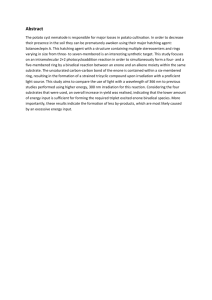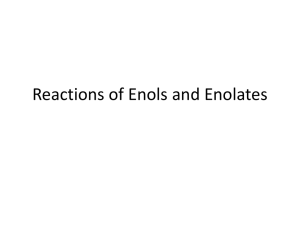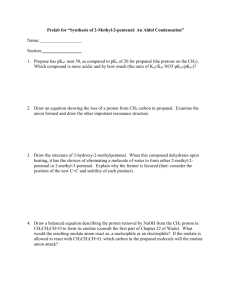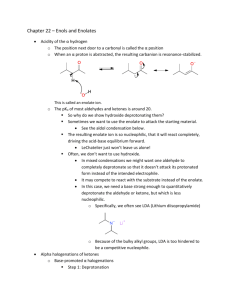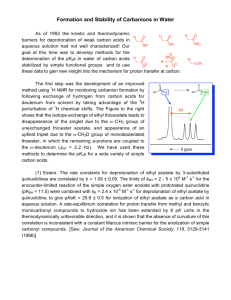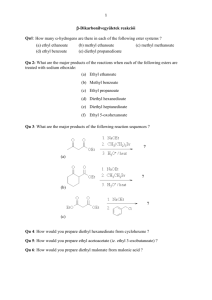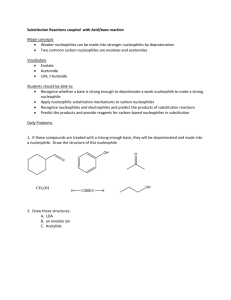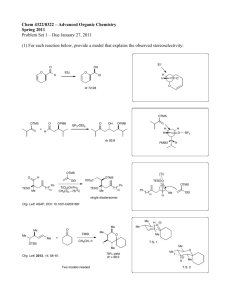Synthetic Organic Chemistry Final Exam Resit (6KM33) Thursday
advertisement
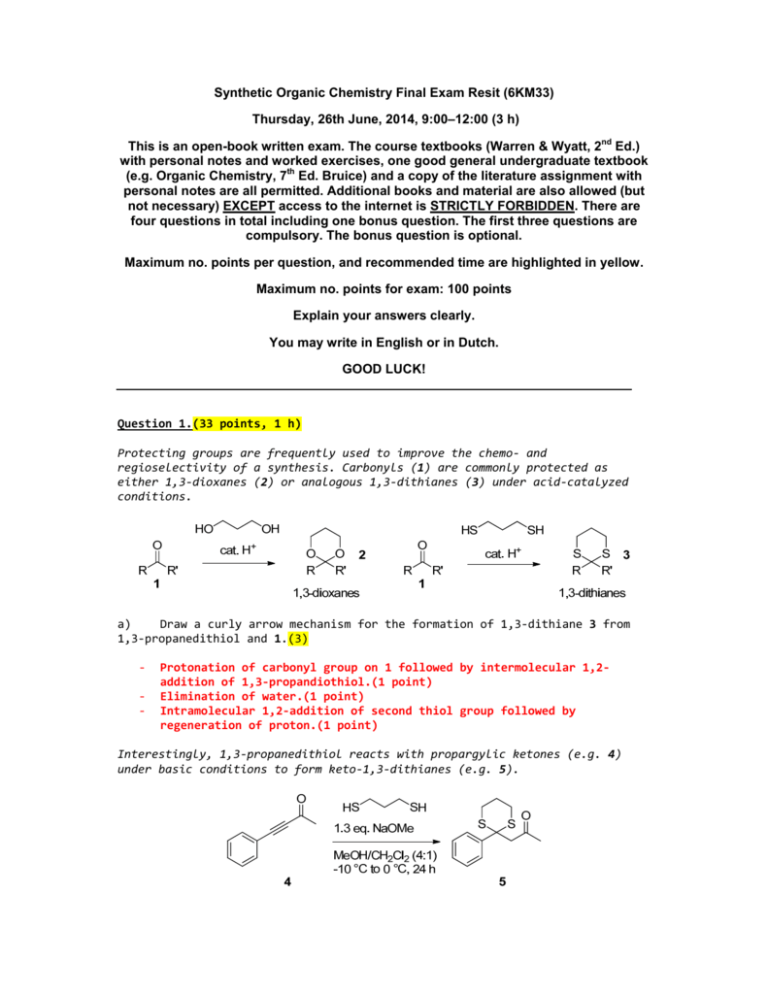
Synthetic Organic Chemistry Final Exam Resit (6KM33) Thursday, 26th June, 2014, 9:00–12:00 (3 h) This is an open-book written exam. The course textbooks (Warren & Wyatt, 2nd Ed.) with personal notes and worked exercises, one good general undergraduate textbook (e.g. Organic Chemistry, 7th Ed. Bruice) and a copy of the literature assignment with personal notes are all permitted. Additional books and material are also allowed (but not necessary) EXCEPT access to the internet is STRICTLY FORBIDDEN. There are four questions in total including one bonus question. The first three questions are compulsory. The bonus question is optional. Maximum no. points per question, and recommended time are highlighted in yellow. Maximum no. points for exam: 100 points Explain your answers clearly. You may write in English or in Dutch. GOOD LUCK! Question 1.(33 points, 1 h) Protecting groups are frequently used to improve the chemo‐ and regioselectivity of a synthesis. Carbonyls (1) are commonly protected as either 1,3‐dioxanes (2) or analogous 1,3‐dithianes (3) under acid‐catalyzed conditions. a) Draw a curly arrow mechanism for the formation of 1,3‐dithiane 3 from 1,3‐propanedithiol and 1.(3) ‐ Protonation of carbonyl group on 1 followed by intermolecular 1,2‐ addition of 1,3‐propandiothiol.(1 point) ‐ Elimination of water.(1 point) ‐ Intramolecular 1,2‐addition of second thiol group followed by regeneration of proton.(1 point) Interestingly, 1,3‐propanedithiol reacts with propargylic ketones (e.g. 4) under basic conditions to form keto‐1,3‐dithianes (e.g. 5). b) Propose a detailed curly arrow mechanism for the formation of 5 from 4 and 1,3‐propanedithiol under the basic conditions described above.(6) ‐ Deprotonation of 1,3‐propandithiol by methoxide base.(1 point) ‐ Michael 1,4‐addition of thiolate to ynone 4 to generate intermediate allenate.(1 point) ‐ α‐protonation of allenate with MeOH as proton source to generate enone intermediate.(1 point) ‐ Second deprotonation of tethered thiol group by methoxide base.(1 point) ‐ Michael 1,4‐addition of thiolate to enone intermediate 4 to generate enolate.(1 point) ‐ α‐protonation of enolate with MeOH as proton source to generate 5.(1 point) Under the same conditions, propargylic ketone 7 does not form 8, but instead undergoes a tandem Michael‐addition‐intramolecular aldol reaction to form 9. c) Draw the structure for 9 and a detailed mechanism for its formation.(6) ‐ ‐ ‐ ‐ ‐ Mechanism as for part b as far as intermediate enolate.(1 point) Intramolecular attack of enolate (1 point) at aldehyde.(1 point) Protonation of alkoxide with MeOH as proton source.(1 point) Elimination of water not needed to score the points Correct structure scores 2 points.(below) d) ‐ ‐ Propose a detailed synthesis of 7 starting from 10‐12.(12) In general, each correct intermediate structure, 1 point; appropriate set of reagents per reaction step, 1 point. A complete answer will score maximum points. ‐ ‐ ‐ All synthetic routes will be considered, so plenty of flexibility here with the marking. Bonus marks may be given (at the examiner’s discretion) for elegant suggestions. e.g. e) Therefore, propose a synthesis of 8 starting from 10‐12.(6) ‐ ‐ ‐ ‐ ‐ ‐ ‐ In general, each correct intermediate structure, 1 point; appropriate sets of reagents per reaction step, 1 point. A complete answer will score maximum points. All synthetic routes will be considered, so plenty of flexibility here with the marking. Bonus marks may be given for elegant suggestions (at the examiner’s discretion). A resonable suggestion might be: Start with 10 c from previous question… Oxidation and protection of aldehyde as 1,3‐dioxane before installation fo 1,3‐dithiane. Mild orthogonal deprotection of 1,3‐dioxane over 1,3‐ dithiane is possible. Question 2.(33 points, 1 h) Amines are important functional groups in chemistry and biology. a) Describe five different ways to introduce an amine functional group into a molecule in no more than 2 steps. For each reaction sequence you do not need to write mechanisms; simply write the structures of the starting material(s), product(s) and any other necessary reagents.(15) ‐ ‐ ‐ ‐ ‐ ‐ Reduction of azides with PPh3 (Staudinger reaction). Reduction of nitriles using LiAlH4. Reduction of amides using LiAlH4. Reduction of nitriles using hydrogen and palladium. Reduction of imines with NaBH4. For each example, starting material, 1 point, choice of reagents above arrow, 1 point, product, 1 point, all clearly written. ‐ No points earned for mechanistic details. α,β‐unsaturated carbonyls are synthetic versatile building blocks, e.g. for the synthesis of 2 and 3 starting from α,β‐unsaturated ketone (enone) 1. b) Briefly explain the difference in reactivity between MeMgBr and Me2CuLi towards 1, for the synthesis of 2 and 3, respectively.(2) ‐ Grignard reagent MeMgBr is a hard nucleophile which acts under kinetic control. This nucleophile adds 1,2 to the carbonyl group.(1 point) ‐ Organocuprate Me2CuLi is a soft nucleophile which acts unde thermodynamic control. This nucleophile prefers to add to add 1,4 at carbon β to the carbonyl group.(1 point) ‐ Similar answers will score. Note: For parts c) and d) multiple synthetic steps may be required. Write clearly all intermediate structures, and suggested reagents. You do not need to provide reaction mechanisms. c) How could you selectively synthesize products 4‐6 starting from enone 5? Suggest suitable reagents A‐C.(12) ‐ Conditions A: 1,2‐addition of PhMgBr Grignard reagent, acid work‐up, then epxodiation using mCPBA (meta‐chloroperbenzoic acid). ‐ Conditions B: 1,4‐addition of Ph2CuLi, acid work‐up, kinetic enolate formation (LDA), then quench with BnBr nucleophile to enable kinetic α‐ alkylation. ‐ Conditions C: 1,4‐addition of soft nucleophile β‐ketoester, methyl 3‐ oxobutanoate, saponification, Krapcho decarboxylation. ‐ In general, 1 point per correct intermediate structure and 1 point for each correc set of conditions. ‐ Total of 4 poitns for each short synthesis. d) How could you convert 6 into 7? Suggest suitable reagents, D.(4) ‐ ‐ Treating with base or acid will lead to ring closure and dehydration to form the enone. Reduction of the enone to 7 using hydrogen and calatytic palladium. In general, 1 point per correct intermediate structure and 1 point for each correct set of conditions. Maximum no. points = 4. ‐ Question 3. (based on literature assignment).(34 points, 45 mins) Citation: Breitler & Carreira, Angew. Chem. Int. Ed., 2013, 52, 11168. Note: compound numbers are identical to those used in the article! With reference to Scheme 3: a) Draw a detailed curly arrow mechanism for the formation of 8 from 6 and 7 over steps a and b.(4) ‐ Step a ‐ Deprotonation of 6 α to ester group and 1,4‐Michael addition at enone 7.(1 point) ‐ Deprotonation of α to ketone and 1,2‐addition at aldehyde to form the six‐membered ring.(1 point) ‐ E1cb elimination of water.(1 point) ‐ Step b ‐ Krapcho decarboxylation of tert‐Butyl ester functional group.(1 point) b) What would be the expected product if compound 8 were reacted under catalytic hydrogenation conditions (e.g.Pd/C/H2)? Explain therefore why the authors chose to use Na/NH3(l)/EtOH instead.(2) ‐ Catalytic hydrogenation conditions would reduce all unsaturated bonds.(1 point) ‐ Birch reduction conditions (Na/NH3(l)/EtOH) are therefore more chemoselective than catalytic hydrogenation.(1 point) Cyclopropane 14 was formed in step j as one of a separable 4.4:1 mixture of two diastereomers. c) Draw the structure of the other diastereomer formed in step j.(2) d) With reference to the structure of compound 12 explain why diastereomer 14 is formed in preference to other possible diastereomers.(3) ‐ ‐ ‐ 1,1‐disubstituted olefin reacts chemoselectively over the trisubstituted olefn (1 point) 1,1‐disubtituted olefin is locked in a conformation that gives rise to facial selectivity due to steric hinderence generated by the alkyl side chain (full arrow and red curve) (1 point) Carbene generated in situ reacts preferentially at the sterically least hindered face of the olefin (dashed arrow) (1 point) The carbon at position 1 in compound 14 (above) is prochiral. e) What do you think is meant by prochiral in this case. Refer to the structure of 14 in your answer.(2) ‐ Carbon at position 1 (C‐1) attached to two identical methyl ester groups and is therefore achiral (A defintion of prochiral:…can be converted from achiral to chiral in a single step). (1 point) ‐ However, conversion of one of these two ester groups to a non‐ equivalent functional group will render the C‐1 carbon chiral.(1 point) f) The other diastereomer hypothetically formed during step k is 15a (see above, but not shown in article). Provide a mechanism for the formation of 15a from 14 in step k, and explain why you think 15 is formed, and not 15a.(4) ‐ Recognizing that the reaction occurs under basic conditions (aq. Sat. NaHCO3). (1 point) ‐ Bond rotation about sp3‐sp3 C‐C bond indicated by red arrow below needed to enable reaction at red‐highlighted ester functional group (1 point) ‐ Base deprotonation of alcohol and formation of lactone. (1 point) ‐ Rotation about indicated C‐C bond is energetically disfavored (steric hinderance; two adjacent quarternary centres), therefore reaction with higlighted ester group is less likely to occur. (1 point) ‐ Any well‐reasoned answer will score points. Me 1 MeO2C Me Me MeO2C bond rotation O OTBS MeO2C 1 MeO2C O lactone formation OTBS MeO2C O OTBS O 14 14 15a - hypothetical diastereomer - g) Is step k a sterespecific or stereoselective reaction? Briefly explain your answer.(3) ‐ ‐ ‐ ‐ Stereoselective. (1 point) Mechanism does not specify the sterechemical outcome of this reaction. (1 point) Both diastereomers can form through rotation about specified bond. (1 point) Any well‐reasoned answer will score points. With reference to Scheme 4: The synthesis of 17 from 16 occurs in a yield of 80% and generates two diastereromers in a ratio (d.r.) of 7.7:1. The structure of the major diastereomer is shown in Scheme 4. h) Draw the full structure of ‐OTBS in compound 16.(2) ‐ Correct structure bags all the points. i) Draw the structure of the the minor diastereomer formed in Scheme 4.(2) ‐ ‐ Any well‐reasoned structure will score the points here. One possibility might be the following: j) With reference to the reaction mechanism proposed in Scheme 4, explain why diastereomer 17 is formed in preference to other possible diastereomers.(3) ‐ One possible explanation: ‐ After elimination of pivolate, formation of samarium enolate.(1 point) ‐ Protonation can theoretically occur at both faces of the enolate.(1 point), ‐ 17 preferred on either theromodynamic or kinetic grounds.(1 point) ‐ Once again, any well‐reasoned answer will score points. With reference to Scheme 5: k) Describe and explain what is happening in step c, providing as much mechanistic detail as possible.(7) ‐ Protection of lactone as triisopropylsilyl ketene acetal using TIPSOTf and NEt3.(1 point) ‐ Increase chemoselectivity. Lactone was found in earlier studies to react with electrophiles in preference to the ketone.(1 point) ‐ α‐deprotonation of ketone with LiHMDS (1 point) and quench with Eschenmoser’s salt (CH2=NMe2+I‐).(1 point) ‐ ‐ ‐ Hofmann elimination (MeI, then basic Al2O3).(1 point) Two additional points for curly arrow mechanism to illustrate the Once again, any well‐reasoned answer will score points. Bonus Question. Total synthesis of Spongistatin 1. Spongistatin 1 is a marine macrolide natural product, which has generated considerable interest in the field due to its potent antitumour properties and outstanding structural beauty. In one reported synthesis of 1, the CD spiroketal fragment 2 was synthesized from chiral enantiomerically pure epoxides 3 and 4. OH AcO Cl A OH HO O O H B O ? H AcO H O C O H F O H HO HO HO O OH O D 28 O H H O C HO 23 H E 16 16 23 OMe spongistatin (1) D 28 S O H OPMB O Cl S O OPMB 28 3 4 2 Propose a synthesis of 2 from 3 and 4 ignoring the stereochemistry at the C23 anomeric carbon. ‐ This is optional. ‐ Any attempts at a sensible answer will score points.
